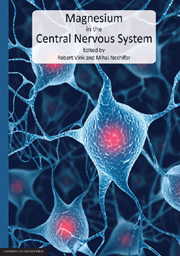Book contents
- Frontmatter
- List of Contributors
- Preface
- Contents
- Section 1 Magnesium in Normal Brain
- Section 2 Magnesium in Neurological Diseases
- Chapter 7 The role of magnesium therapy in learning and memory
- Chapter 8 The role of magnesium in headache and migraine
- Chapter 9 Magnesium in edema and blood-brain barrier disruption
- Chapter 10 Magnesium and hearing loss
- Chapter 11 The role of magnesium in pain
- Chapter 12 The role of magnesium in traumatic CNS injury
- Chapter 13 The use of magnesium in experimental cerebral ischaemia
- Chapter 14 Magnesium in subarachnoid hemorrhage
- Chapter 15 Magnesium in clinical stroke
- Chapter 16 Magnesium in cancer: more questions than answers
- Chapter 17 Magnesium in Parkinson's disease: an update in clinical and basic aspects
- Section 3 Involvement of Magnesium in Psychiatric Diseases
Chapter 8 - The role of magnesium in headache and migraine
from Section 2 - Magnesium in Neurological Diseases
Published online by Cambridge University Press: 05 June 2012
- Frontmatter
- List of Contributors
- Preface
- Contents
- Section 1 Magnesium in Normal Brain
- Section 2 Magnesium in Neurological Diseases
- Chapter 7 The role of magnesium therapy in learning and memory
- Chapter 8 The role of magnesium in headache and migraine
- Chapter 9 Magnesium in edema and blood-brain barrier disruption
- Chapter 10 Magnesium and hearing loss
- Chapter 11 The role of magnesium in pain
- Chapter 12 The role of magnesium in traumatic CNS injury
- Chapter 13 The use of magnesium in experimental cerebral ischaemia
- Chapter 14 Magnesium in subarachnoid hemorrhage
- Chapter 15 Magnesium in clinical stroke
- Chapter 16 Magnesium in cancer: more questions than answers
- Chapter 17 Magnesium in Parkinson's disease: an update in clinical and basic aspects
- Section 3 Involvement of Magnesium in Psychiatric Diseases
Summary
Abstract
Magnesium's role in migraine pathogenesis is well-described, with deficiencies known to promote cortical spreading depression, alter nociceptive processing, and neurotransmitter release and encourage the hyperaggregation of platelets, all major elements of migraine development. Research on magnesium has found it to be a potentially well-tolerated, safe and inexpensive option for migraine prevention, while it may also be effective as an acute treatment option for headaches including migraines, tension- type headaches and cluster headaches, particularly in certain patient subsets. This chapter will review the various aspects of migraine in which magnesium plays a part, as well as numerous studies on the use of magnesium in both headache prophylaxis and in the acute treatment of headaches, offering recommendations in its use in clinical practice.
Magnesium in the Body
Magnesium (Mg), the second most abundant intracellular divalent cation, is a cofactor of many enzymes and is involved in a plethora of cellular functions. It plays a central role in both glucose metabolism and in ATP function. Over 300 enzymes require the presence of magnesium ions for their catalytic action, including all enzymes utilizing or synthesizing ATP, or those that use other nucleotides to synthesize DNA and RNA. ATP exists in cells as a chelate of ATP and a magnesium ion.
- Type
- Chapter
- Information
- Magnesium in the Central Nervous System , pp. 125 - 134Publisher: The University of Adelaide PressPrint publication year: 2011

